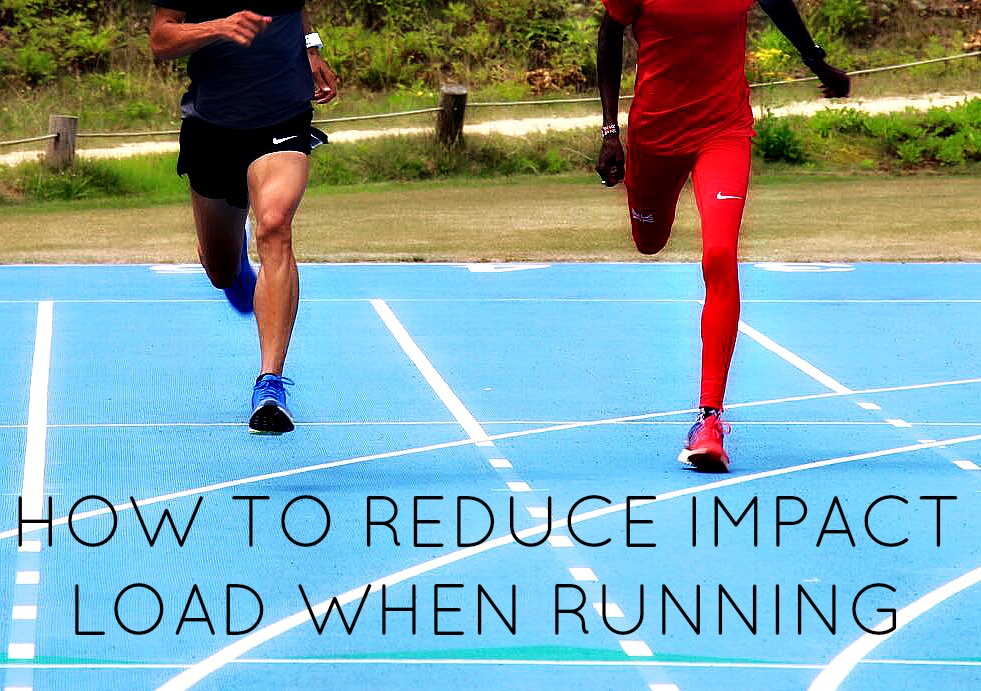In running, impact load is a force variable that affects the muscles, tissues, joints and bones and is also dissipated by tissues. In most cases, loading can strengthen soft tissues, if the rate of loading is under biologically tolerable magnitudes.
With that said, safe loading rates are important for soft tissue health because it strengthens tissues. However, repeated and prolonged exposure to high loads without sufficient periods of rest to allow adaptation results in tissue overloading and damage.

How to Reduce Impact Load When Running
An easy way to reduce impact loading is to avoid heel strike running and instead, run on your forefoot. Zadpoor and Nikooya (2011) found that heel strike running produced an impact peak at touchdown, which indicated high bone loading that increased fatigue load of soft tissues.
Heel strike running also produces high rates of cyclic loading because at heel strike, braking and compressive forces are high. It also became clear that heel strike running generates higher loading because there is a larger downward velocity of the ankle coupled with a lack of counterbalancing quadricep force, resulting in a larger heel strike transient and loading.
Below, shows a video of how high loading was quantified in heel strike running:
In the above clip, the vertical dropping of the pen represents the heel colliding with the ground at touchdown in heel strike running, causing rapid braking and high loading.
Most joggers heel strike, but there is something undeniably familiar about the injury pattern in these runners. These injuries seem related to the impact peak (i.e. high loading).
- Lieberman et al. (2010) demonstrated that switching to a forefoot strike landing results in low-level loading cycles, suggesting that forefoot running is a safe and tolerable running style.
The turning point in our understanding of high loading and injury in running came from Hreljac (2004) who suggested that since high loading occurs very early in stance, the magnitude of loading is dependent on running mechanics prior to touchdown. This jibes with Lieberman’s work which proved that habitual barefoot runners mechanically reduce loading by landing forefoot first, heel last.
Above, shows the foot/ground interaction in forefoot running reducing high loads. The foot approaches the ground less vertically, and more horizontally, almost parallel relative to the ground, which allows for a smoother transition from flight to stance.
The Take Home Message
What is important about these findings is that improvements to reduce loading in running can only occur during the touchdown phase. It was not until Lieberman revisited the question: how can loading be reduced in running, that it became clear that modifying foot strike, could, in fact, be necessary for this improvement to occur. In other words, running –in all it’s phases –landing on the forefoot at touchdown does something to reduce loads that heel strike running does not do.
More From Run Forefoot:
- Barefoot Running Advanced Training Plan
- Learning to Forefoot Strike
- Forefoot Running Improves Plantar Fasciitis, not Causes it
- Running with Sural Nerve Pain
- Choosing the Right Shoe
- The Rock-Star Way to Fuel Before a Race
References:
Hreljac, A., 2004. Impact and overuse injuries in runners. Med. Sci. Sports Exercise
36, 845–849.
Jefferson, R.J., Collins, J.J., Whittle, M.W., Radin, E.L., O’Connor, J.J., 1990. The role of
the quadriceps in controlling impulsive forces around heel strike. Proc. Inst. Mech. Eng. H 204, 21–28.
Lieberman, D.E., Venkadesan, M., Werbel, W.A., Daoud, A.I., D’Andrea, S., Davis, I.S., Mang’Eni, R.O., Pitsiladis, Y., 2010. Foot strike patterns and collision forces in habitually barefoot versus shod runners. Nature 463, 531–535.
Schmitz et al. Variables during swing associated with decreased impact peak and loading rate in running. J Biomech, 2014; 47:32-38.
Zadpoor, A.A., Nikooyan, A.A., 2011. The relationship between lower-extremity stress fractures and the ground reaction force: a systematic review. Clin. Biomech. 26, 23–28.
Bretta Riches
BSc Neurobiology; MSc Biomechanics candidate, ultra minimalist runner & founder of RunForefoot. I was a heel striker, always injured. I was inspired by the great Tirunesh Dibaba to try forefoot running. Now, I'm injury free. This is why I launched Run Forefoot, to advocate the health & performance benefits of forefoot running and to raise awareness on the dangers of heel striking, because the world needs to know.
Latest posts by Bretta Riches (see all)
- Can You Run In Barefoot Shoes? Yes, But DON’T Heel Strike! - 21/07/2024
- Why Cushioned Running Shoes Are Really Bad for Your Feet - 19/07/2024
- Do Cushioned Running Shoes Cause Injuries? - 17/07/2024

Leave a Reply